Abstract
Introduction:
Paper is written on the basis of data collected in collaboration with family doctors in several cities in Bosnia and Herzegovina.
Material and methods:
In this retrospective, randomized study was carried out processing of data collected by special design questionnaire from the field through studies and analyzes carried out in 5 health care institutions in the territory of Bosnia and Herzegovina. The study included 270 patients who underwent three consecutive medical examinations.
Results:
Total reduction in blood pressure in average was 32.8 mmHg for systolic and 17.1 mmHg for diastolic, which is consistent with previously published results. Lisinopril/Hydrochlorothiazide is therefore a valuable therapy in the field of internal medicine. Study of this medication confirmed its efficacy in the treatment of hypertension.
Conclusion:
Control of high blood pressure in our patients according to data was very low, so it is necessary to intensify measures of prevention and treatment.
Keywords: hypertension, treatment, Lisinopril/hydrochlorothiazide
1. INTRODUCTION
1.1. Hypertension
Hypertension is the most important chronic health problem (1-7). It is estimated that hypertension affects about one billion people, and the number will increase by 60% until 2025 (7). According to the World Health Organization and the International Society of Hypertension, high blood pressure is defined when the systolic blood pressure is 140 mmHg (18.7 kPa) or more, and/or level of diastolic blood pressure is 90 mmHg (12.0 kPa) or more, after repeated measurements. It can occur as isolated systolic or diastolic hypertension but it is usually case of elevated both systolic and diastolic pressure. Due to the changes that occur in the large arteries because of aging, systolic blood pressure after the age of 50 increases with every year of life by about 2 mmHg and diastolic blood pressure by 0.5 to 1 mmHg (4).
Most of the patients with hypertension have essential or primary hypertension with unknown cause, and in which the initially high blood pressure is the only manifestation of the disease. In other patients the hypertension is caused by disease of some other organs and therefore is referred to as secondary hypertension. The degree of clinical severity of hypertension is estimated based on the values of blood pressure and current changes in other organ systems (5, 6). For hypertension treatment today at all level of healthcare protection there are a lot of drugs based on different pharmacological and pharmacokinetic effects. Some of them are:
* Lisinopril: is a potent ACE inhibitor and a potent antihypertensives belonging to the third generation of ACE inhibitors. It represents a lysine analog of the enalapril, and unlike it is directly active. With such action it interferes with any component of the renin-angiotensin-aldosterone system separately. From this derive all of its pharmacodynamics and therapeutic effects. It is used in treatment of hypertension and heart failure, as well as myocardial infarction and diabetic nephropathy prophylaxis (1-3).
* Hydrochlorothiazide: is a diuretic from the group of thiazides. Its primary pharmacodynamics effect is as diuretic. The antihypertensives effect resulting from its diuretic effects and their direct consequences. Hydrochlorothiazide is a diuretic and antihypertensives agent. Reduces the reabsorption of electrolytes in distal tubule of the kidney that increases urine output, reducing the volume of blood in the blood vessels and contributes to lowering blood pressure (1-3).
* Our study confirmed high efficacy in the treatment of hypertension with the combination of ACE inhibitor Lisinopril and the diuretic hydrochlorothiazide, which provides an additional antihypertensives effect.
2. Goals
Evaluate patients suffering from hypertension who were treated with a combination of Lisinopril/hydrochlorothiazide, in 5 health institutions in Bosnia and Herzegovina with an emphasis on the effectiveness of it’s antihypertensives effect. Determine the mean blood pressure values in the studied group patients by measuring blood pressure in the studied time period: two months (first, second and third measurement). Provide a cross section of the Lisinopril/hydrochlorothiazide antihypertensives effect based on three measurements
Identify the differences between the patients in our study in relation to gender, age and age groups.
3. PATIENTS AND METHODS
The data used in our study were obtained from the studies and analyzes carried out in 5 health care institutions at the territory of Bosnia and Herzegovina. The study included 270 patients who underwent three consecutive medical examinations after being on Lisinopril/hydrochlorothiazide therapy. Patients evaluated in our study underwent three examinations over a period of two months. The criterion for inclusion was hypertension. Every physician/doctor evaluated a group of patients. All doctors/physicians keep track of hypertension in a specially designed table. After collection, the data are converted into the group study which results we presented in tables and charts.
The necessary data for following Lisinopril/hydrochlorothiazide performance are collected on the basis of medical examinations and doctor’s notes:
History and status preasens;
Measuring blood pressure during the first, second and third examination;
Maintaining records of adverse events during the three examinations;
Laboratory tests;
Diagnostic tests.
The research results are presented in tables and charts by the number of cases, percentage, mean with standard deviation and range of values. Analysis of statistical significance of the differences is conducted by Pearson and Yates chi-square test and one-way analysis of variance (ANOVA). The results of all these tests with p<0.05 or the confidence level of 95% were considered statistically significant. The analysis was performed using the statistical package IBM SPSS Statistics v19.0 (Chicago, Illinois, USA).
4. RESULTS
Results of our investigation are presented on tables and graphs.
Sample overview
Majority of patients required higher dose of Lisinopril/hydrochlorothiazide a 20 mg (185 or 68.5%) (Table 1) which can be explained by the older age of the patients (59±12 years; 34-88 years) ((Table 2). Female patients were more prevalent in the sample (165 or 61,1%).
Table 1.
Summary of the total sample (N = 270). The numbers in the second column represents N (%) and in case of average values–mean +/- standard deviation (min-max range).
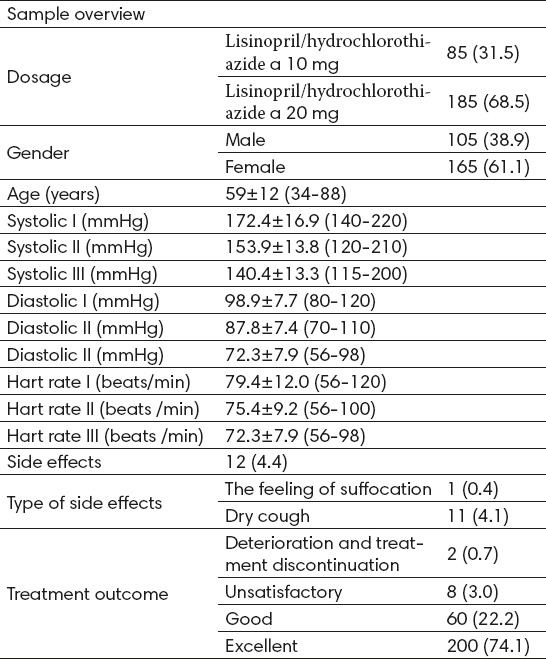
Table 2.
Comparison of mean age by L/H dose, t=-0.828; p=0.409

There is a decrease in systolic blood pressure from 172.4±16.9 mmHg in first measurement, to 153.9±13.8 mmHg during second, and to 140.4±13.3 mmHg during third measurement. Also there is a decline in diastolic blood pressure from 98.9±7.7 mmHg during first, to 87.8±7.4 mmHg during second and to 72.3±7.9 mmHg during third measurement. Hearth rate also slightly decreased from 79.4±14 BPM during first, to 75.4±9.2 BPM during second and finally to 72.3±7.9 BMP during third measurement. Side effects were recorded in 12 or 4.4% of cases, or in one case the feeling of suffocation and in 11 cases in form of dry cough. Treatment outcome was mostly excellent (200 or 74.1%), then good (60 or 22.2%). In 8 or 3% of cases the treatment outcome was unsatisfactory and 2 or 0.7% of patients had deterioration so the treatment was discontinued.
Comparison by Lisinopril/hydrochlorothiazide (L/H) dosage
Comparison of mean age by Lisinopril/hydrochlorothiazide dose indicate that patients on L/H 20 was just slightly older with mean age of 59.4 years compared to patients on L/H 10 and average age of 58.1 years, which does not represent a statistically significant difference.
Overview of systolic pressure over three measurements
Mean values of systolic blood pressures was lower in a group of patients receiving Lisinopril/hydrochlorothiazide a 10 mg during all three measurements, with statistically significant difference between group during the first and second, but not the third measurement (Figure 1).
Figure 1.
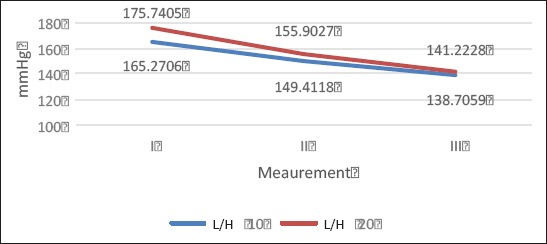
Review of systolic pressure over three measurements
Review of diastolic pressure through three measurements
The mean values of diastolic blood pressure were significantly different only during the first measurement when higher mean value was recorded in the group of patients receiving L/H a 20 mg. During the second measurement the mean values of diastolic BP was identical, and during the third measurement the mean vale of diastolic BP was slightly higher in a group of patients on Lisinopril/hydrochlorothiazide a 10 mg but without significant difference (Figure 2).
Figure 2.
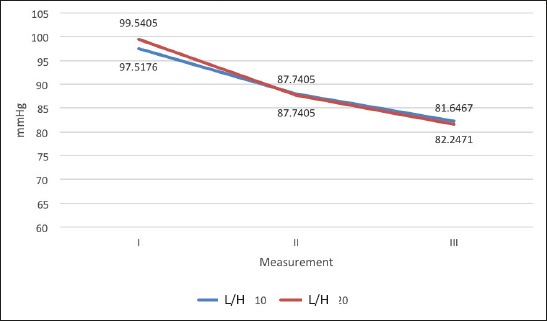
Review of diastolic pressure through three measurements
Review of heart rate through three measurements
Mean hearth rate was higher during all three measurements in a group of patients on L/H a 20 mg, but with statistically significant difference only during the first measurement (Figure 3).
Figure 3.
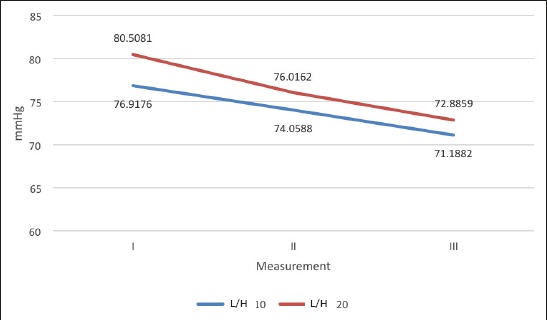
Review of heart rate through three measurements
Overview by gender and Lisinopril/hydrochlorothiazide dose
Women was more represented in both groups of patients without significant difference (Table 3).
Table 3.
Overview by gender and L/H dose; χ2=0.675; p=0.247
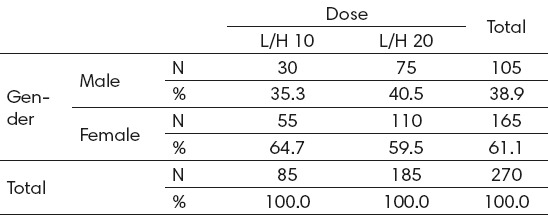
Review of side effects in the sample
As expected, the higher dose of the medication produced more side effects or 11 (5.9%) in a group of patients on Lisinopril/hydrochlorothiazide a 20 mg, compared to one (1.2%) patient in a group of Lisinopril/hydrochlorothiazide a 10 mg. This difference cannot be considered as statistically significant (Table 4).
Table 4.
Review of side effects in the sample; χ2=3.120; p=0.065
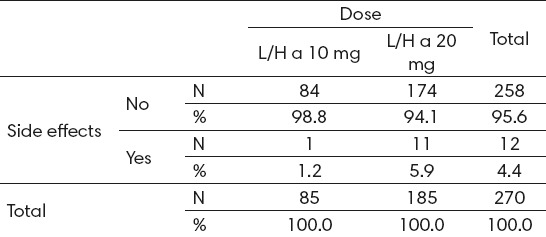
The types of side effects
One patient in group on L/H a 10 mg had the dry cough, and majority of patients in the group on L/H a 20 mg and with side effects had the same, with one patient reporting the feeling of suffocation (Figure 4).
Figure 4.
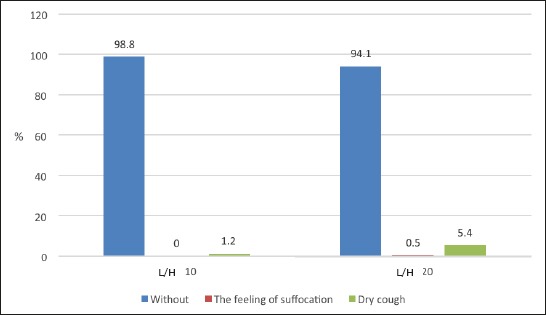
The types of side eff ects (χ2=3.155; p=0.207)
Treatment efficacy was almost identical with just slightly better efficacy in a group of patients treated with L/H a 10 mg (Figure 5).
Figure 5.
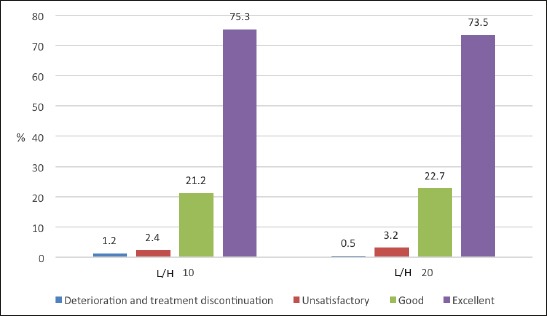
Treatment effi cacy (χ2=0.560; p=0.906)
5. DISCUSSION
Our study included 270 patients. Review of gender structure of the sample indicated that women were slightly more prevalent with 165 or 61.1% cases compared to men with 105 or 38.9% of cases. The analysis of the sample according to the dose of Lisinopril/hydrochlorothiazide a 10 mg and 20 mg shows that the majority of respondents was necessary to introduce L/H a 20 mg (68.5%) while L/H a 10 mg was sufficient to regulate hypertension in 31.5% of respondents. This difference is attributed to the age of the respondents in the sample.
Analysis of the average systolic blood pressure during the first examination, the first control, and other controls showed a linear decrease and the difference between groups was statistically significant during the first and second measurement but not during third, which favors rapid action of the L/H. Analysis of the average diastolic blood pressure showed a linear decrease in the difference between the groups where there is a statistically significant difference in the first and second measurements.
The combination of ACE inhibitor Lisinopril and the diuretic hydrochlorothiazide provides an additional antihypertensives effect. Lisinopril is a potent ACE inhibitor, a potent antihypertensives belonging to the third generation of ACE inhibitors. It is used in treatment of hypertension and heart failure, as well as myocardial infarction and diabetic nephropathy prophylaxis (1-3). Hydrochlorothiazide is a diuretic from the group of thiazides. Hydrochlorothiazide is a diuretic and antihypertensives agent. It reduces the reabsorption of electrolytes in distal kidney tubule which consequently increases urine output, reducing the volume of blood in the blood vessels and contributes to lowering blood pressure (1-3). The initial blood pressure during the first measurement averaged at 172.8 mmHg for systolic blood pressure and 98.9 mmHg for diastolic blood pressure. After one month of treatment with L/H a systolic blood pressure was reduced to an average of 153.8 mmHg and DBP to 87.7 mmHg. The reduction was also recorded during the third measurement, when the average systolic blood pressure was 140 mmHg and diastolic blood pressure 81.8 mmHg. Total reduction in blood pressure in average was 32.8 mmHg for systolic and 17.1 mmHg for diastolic, which is consistent with previously published results. During treatment has been reported a total of 12 side effects, or in 12 cases (dry cough) of the total of 270 and these results are similar to those of which are reported in previous studies of Lisinopril/hydrochlorothiazide.
Lisinopril/hydrochlorothiazide is because of that valuable therapy in the field of internal medicine. A study of this preparation confirmed its efficacy in the treatment of hypertension.
6. CONCLUSION
Study was conducted on 270 patients in five health institutions of Bosnia and Herzegovina. Criteria for introduction of L/H in therapy was newly discovered hypertension, hypertension that has not responded to previous treatment or could not be continued because of side effects. During treatment the patient’s blood pressure, as the main indicator, was measured at the first examination of the patient, then the first control and the second follow-up examination. The average blood pressure in the first examination amounted to 172/98 mmHg, while in the first follow-up examination was 133/87 mmHg, and the second follow-up examination 140/81 mmHg. Based on these results we conclude that the L/H is effective drug in the treatment of mild to moderate hypertension.
Also was conducted evaluation of documented treatment adverse effects where it was found that there is no deviation from the previous study of treatment of hypertension with similar drugs. Data from this study indicate that both systolic and diastolic blood pressure significantly decreased after 8 weeks of treatment with L/H. Lisinopril/hydrochlorothiazide has proven as effective and safe antihypertensives drug in treatment of mild to moderate hypertension. The total clinical efficacy was assessed as excellent which is interpreted as a reduction in blood pressure to the target value in most patients.
Footnotes
• Conflict of interest: none declared.
REFERENCES
- 1.Antihypertensives effectiveness of low-dose Lisinopril-hydrochlorothiazide combination. A large multicenter study. Lisinopril-Hydrochlorothiazide Group., Chrysant SG. Arch-Intern-Med. 1994 Apr 11;154(7):737–43. [PubMed] [Google Scholar]
- 2.Angiotensin converting enzyme inhibitors enhance the antihypertensives efficacy of diuretics and blunt or prevent adverse metabolic effects. Weinberger MH. 1989. J. Cardiovascular. Pharmacol. 13:S1–S4. doi: 10.1097/00005344-198900133-00002. [DOI] [PubMed] [Google Scholar]
- 3.Patlak M. “From viper's venom to drug design: treating hypertension”. FASEB J. 2004 Mar;18(3):421. doi: 10.1096/fj.03-1398bkt. [DOI] [PubMed] [Google Scholar]
- 4.Katzung Bertram. Basic and Clinical Pharmacology. Vol. 175. New York City, New York: McGraw Hill; 2012. pp. 184–185. [Google Scholar]
- 5.Drug Information for the Health Care Professional (USP DI) (2001): Lisinopril. (21th ed) I:171–179. [Google Scholar]
- 6.Li Q, Cheng T, Wang Y, Bryant SH. PubChem as a public resource for drug discovery. Drug Discov Today. 2010;15(23-24):1052–7. doi: 10.1016/j.drudis.2010.10.003. [DOI] [PMC free article] [PubMed] [Google Scholar]
- 7.Masic I, Dilic M, Raljevic E, Vulic D, Mott D. Trends in cardiovascular diseases in Bosnia and Herzegovina and perspectives with HeartScore Programme. Med Arh. 2010;64(5):260–3. doi: 10.5455/medarh.2010.64.260-263. [DOI] [PubMed] [Google Scholar]


